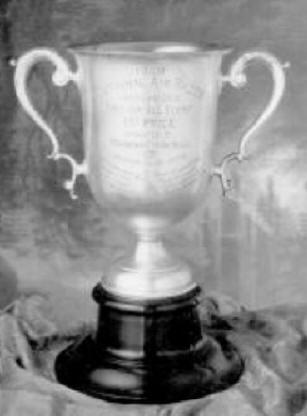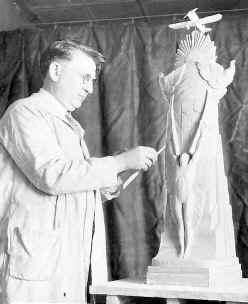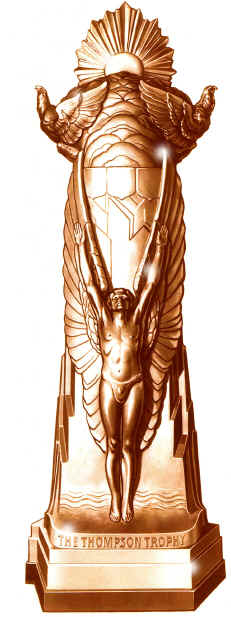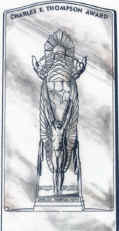
Cleveland Press Archives (CSU)
THE THOMPSON TROPHY STORY
By Bill Meixner
Early in the summer of 1929, Cleveland buzzed with excitement
about the National Air Races scheduled to come to town. Mr. Lee Clegg
of Thompson Products
was approached by a volunteer worker of the National Air Races to ask if Thompson Products
Co. would provide a trophy for one of the many races being held for the first time in
Cleveland. Clegg and Ray Livingstone looked over the list of races needing a trophy and
discovered that, for whatever reason, no other company chose to provide a trophy for the
International Land Plane Free-For-All.
Clegg sent Livingstone to the Webb C. Ball Co. where he purchased a large loving cup for the sum of $25 plus $10 for the engraving.

Cleveland Press Archives (CSU)
With the major success of the 1929 races in Cleveland, including Doug Davis winning the cup in a civilian Travel Air, Livingstone and Clegg suggested to Charles E. Thompson that a sanction be obtained from the National Aeronautic Association to establish a permanent Thompson Trophy and this was done.
A deed of gift for the Charles E. Thompson Trophy was drawn up along with a set of flexible rules to apply to the race. Mr. Thompson felt most trophies, were very poor and incorrect from a standpoint of art. Fred Witt wrote a remarkable description of the symbolism and inspiration the company felt the trophy should express.
Dr. Henry Turner Bailey, a national art authority, suggested
the company contact four notable United States sculptors to prepare clay sketches. Dr.
Bailey, aided by a committee of Orville Wright, David Ingalls, Assistant Secretary of the
Navy for Aeronautics, Hon. F. Trubee Davidson, Assistant Secretary of War for Aeronautics;
and Col. Clarence Young, Assistant Secretary of Commerce for Aeronautics, would judge the
sketches. When the five plaster sketches were received, Livingstone took them first to
Dayton, Ohio for Orville Wright to judge, he than took them to Washington DC for the
Secretaries opinion and than back to Dr. Bailey in Cleveland.

Unanimously, the five judges chose the design submitted by
Walter A. Sinz, of Cleveland, as the most appropriate. This work
was excellent in workmanship and rich in idealism and significance.
The trophy was fashioned of bronze,
mounted on a black marble base. It represented Icarus, the first man
to
fly, according to Greek mythology, with wings spread, facing skyward, symbolizing man's ever-constant
desire to fly. A tapered cliff rises behind Icarus, suggesting man's
progress in conquering the air throughout
the centuries. In bas relief about the cliff are sculptured epochal
milestones in man's attainment of great
speeds. Above the cliff are billowy clouds, perched eagles, and a
rising sun; and surmounting all is the
high-speed airplane that won the last years Thompson Trophy Race.
(Note: this was done for two years
and than was discontinued). Names of the winning pilots were to be engraved on
the ten shields mounted
beneath the clouds.


According to the terms of the deed of gift, the trophy was to be in competition for at least ten years, after which it could be retired or continued at the discretion of the National Aeronautic Association. It was to be awarded annually to the foreign nation, department of government service, organization or chapter of the National Aeronautic Association represented by the winning pilot, (a plan never actually followed) to be properly exhibited until one month prior to the date it is next competed for. He also posted an endowment fund with the National Aeronautic Association, interest on which will be used to annually purchase gold, silver and bronze plaques of the trophy, to be awarded to the first three pilots in the race. Upon the trophy being retired, this fund would revert to the National Aeronautic Association for the use as that organization saw fit in the promotion of aeronautics. .
Walter Sinz later prepared two ten-foot models of the trophy to
be used at various sites to promote the race.
Mr. Thompson expressed the wish that the prize money for the event also be consistent with its importance, with other awards made in similar circumstances, and in keeping with the ideas of the National Aeronautic Association. To carry out this intention, Mr. Thompson volunteered an amount, equal to the sum posted by the Chicago Air Race Corporation for the first flying year of the race. This body appropriated $5,000 and Mr. Thompson contributed a like amount, bringing the total prize money to $10,000, more than had ever been posted for an air speed contest.
The Thompson was an unlimited race in that there were no physical restrictions placed on the airplane as to engine size, number of engines, etc., although a qualifying speed had to be met. Later a restriction was included that said no women were allowed to enter.
Several days before the 1939 Thompson Trophy, Hitler’s
troops marched into Poland and World War II started. Also the deed of gift from Charles
Thompson expired and no one could foresee the resumption of the National Air Races.
World War II ended in August 1945 and the nation, tired of the
horrors of war, wanted the return of things that were normal prior to the war. Race
organizers decided to resume Labor Day weekend 1946.
The quantum leap in speed of the military fighters could not be matched by civilian-built race planes and the race pilots turned to ex-military surplus fighters. Also, the development of the jet powered airplanes with their higher speeds interested the race officials.
It was decided to have two divisions of the Thompson Trophy race. One for piston powered engines and one for jet powered. This presented two problems for the Thompson Trophy sponsor: one, Roscoe Turner, three time winner of the trophy refused to relinquish it; two, with the addition of a jet division, two trophies were now needed. Fortunately, the mold for the original was found and two new ones were cast. The trophy’s name at the base was changed from "Charles E Thompson Trophy" to "The Thompson Trophy" and a small placard for the "R Division" and the "J Division" was added to the respective trophy.
The post-war National Air Races were held in Cleveland from
1946 to 1949 with local pilot Cook Cleland winning the Thompson Trophy "R
Division" twice. The Air Force flew the "J Division" races. Thompson
Products retained both of the Trophies and donated the "R Division" trophy to
the Crawford Auto Aviation Museum in Cleveland. The "J Division" trophy was
donated to the Air Force Museum at Dayton, Ohio. Roscoe Turner’s, Charles E Thompson
trophy was donated to the National Air & Space Museum by his wife Madonna, soon after
his death.
| YEAR | LOCATION | PILOT | PLANE | NO | SPEED |
| 1929* | Cleveland | Doug Davis | Travel Air | 29 | 194 |
| 1930 | Chicago | Speed Holman | Laird | 77 | 201 |
| 1931 | Cleveland | Lowell Bayles | Gee Bee Z | 4 | 236 |
| 1932 | Cleveland | Jimmy Doolittle | Gee Bee R-1 | 11 | 252 |
| 1933 | Los Angeles | Jimmy Wedell | Wendell-Williams | 44 | 237 |
| 1934 | Cleveland | Roscoe Turner | Wedell-Williams | 57 | 248 |
| 1935 | Cleveland | Harold Neumann | Howard Mr Mulligan | 40 | 220 |
| 1936 | Los Angeles | Michel Detroyat | Caudron C-460 | 100 | 264 |
| 1937 | Cleveland | Rudy Kling | Folkerts Sk-3 | 301 | 256 |
| 1938 | Cleveland | Roscoe Turner | Turner LTR | 29 | 283 |
| 1939 | Cleveland | Roscoe Turner | Turner LTR | 29 | 282 |
Post World War II
| 1946 | Cleveland | Alvin "Tex" Johnston | Bell P-39 Q | 84 | 373 |
| 1947 | Cleveland | Cook Cleland | Cosair F2G | 74 | 396 |
| 1948 | Cleveland | Anson Johnson | NAA P-51-D | 45 | 383 |
| 1949 | Cleveland | Cook Cleland | Cosair F2G | 94 | 397 |
Post World War II National Air Races Military Speed Dashes
| 1951 | Detroit | Colonel Ascani | F86-E | USAF | 635 |
| 1953 | Dayton | Brig. General Holtoner | F86-D | USAF | 690 |
| 1954 | Dayton | Captain Sonnenberg | F86-H | USAF | 692 |
| 1955 | Edwards AFB | Colonel Hanes | F100-C | USAF | 822 |
| 1956 | China Lake NAS | Commander Windsor | F8U-1 | USN | 1015 |
| 1957 | Majave | Major Drew | F101-A | USAF | 1207 |
| 1958 | Edwards AFB | Captain Irwin | F104-A | USAF | 1404 |
| 1959 | Edwards AFB | Major Rogers | F106-A | USAF | 1525 |
| 1961 | Edwards AFB | Major Confer Major Weir Navigator Capt Bialas DSO |
B-58 | USAF | 1284
|
* Thompson Cup

Please send comments to Bill Meixner
You are the
th person to pop in on us
since July 12th ,2002, Thank You for the touch & go, please take an early flight
back....
Site last changed on Monday, February 18, 2013 04:13 PM